A canner’s garden is not your typical vegetable patch. With its full-scale production, distinctive varieties and four-season harvests, it’s more for the future than the moment.

“Canner’s gardens aren’t really so different in what they grow. Where they’re really different is in how much they grow,” said Daniel Gasteiger, author of Yes You Can! And Freeze and Dry It, Too (Cool Springs Press, 2011).
“Do some serious planning,” said Gasteiger, of Lewisburg, Pennsylvania. “How often do I serve corn? How often do I serve broccoli? Then consider how often you’ll use it in the form you’ll use to preserve it. I use broccoli much more often fresh than I do frozen.”
The biggest challenge facing food preservationists tends to be determining how much to grow. The Louisiana State University AgCenter has created a vegetable production chart for expected crop yields per 100-foot rows of:
- Lima beans (Bush): 1 bushel shelled or 32 pounds
- Beets: 100 pounds
- Cabbage: 85 heads
- Corn: 120 ears
- Pepper (Bell): 125 pounds
- Squash (Winter): 150 pounds
- Cucumbers: 170 pounds
- Strawberries: 170 pounds
- Tomatoes (Slicers) 250 pounds
If you only have a 50-foot row of a crop, cut the posted yield in half, LSU says. If you have a 10-foot row, then use one-tenth of the posted yield.
“The smaller your space, the more important it is to use succession gardening,” Gasteiger said.
That means planting a second crop in the same space after the first one is harvested. Shop for short-season varieties if planting successive crops.
Also, choose cultivars carefully. Some are better than others for canning, freezing or dehydrating.
“If you’re going to plant to preserve, you’ll probably want the highest density (yielding) producers you can get,” Gasteiger said. “Canning tomatoes are typically much firmer and less flavourful than slicing tomatoes, but better (for canning) because they hold together when cooked.”
How long do canned foods last?
“If the food was canned safely, it should remain safe indefinitely. No pathogens should grow on them,” said Jeanne Brandt, a professor and Master Food Preserver co-ordinator with Oregon State University. That program trains and certifies volunteers who help county Extension staff provide food safety and preservation information.
“Try not to preserve more than you can consume in a year or two though because the quality deteriorates,” Brandt said. “It breaks down in the jar. It toughens. The colour also changes dramatically.”
Kimberly Culbertson of Hillsboro, Oregon, is a Master Gardener who later earned a Master Food Preserver certificate.
“I got into preserving in part because it’s a step up from gardening,” she said. “I used to be in a rush to give away any surplus fresh vegetables before they’d spoil. Now, as canned, I can share them throughout the year.”
She also recommends freezing, pickling and dehydrating as a way of preserving different food groups and offering up different flavours.
“I individually quick-freeze fresh fruit, then package it for the deep freeze so I can portion it out for cooking and snacking,” she said. “Dried fruits concentrate flavours and sweetness and add another dimension to cooking.
“I pickle peppers and they can easily,” Culbertson said. “Tomatoes bring back summer every time I open a jar.”

Comments